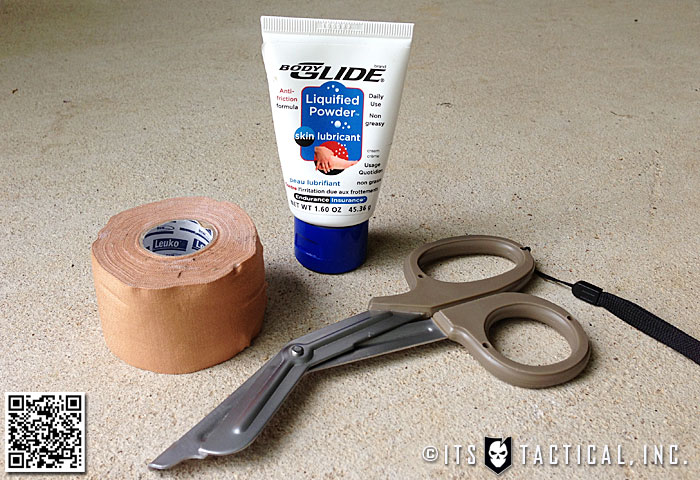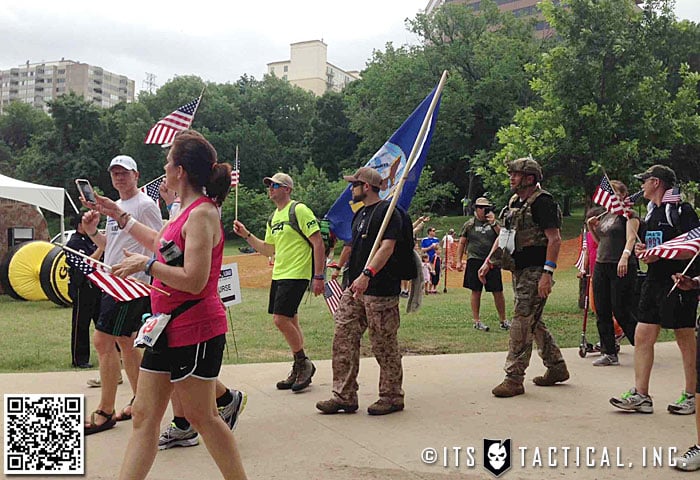Taking Care of Your Feet: Preventing Blisters with Leukotape and a Little Common Sense
Taking Care of Your Feet: Preventing Blisters with Leukotape and a Little Common Sense
Ask any accomplished runner, hiker, backpacker, or outdoorsman how they prevent blisters and you’ll more than likely get different answers from each person you run across.
Today, I’d like to share what’s been working for me and my experience with Leukotape. First off, I’ll share my history with blisters and how my evolution in activity has led me to this point.
High Mileage
I can’t share my history with blisters without mentioning the long mileage we put in weekly during my time at BUD/s (Basic Underwater Demolition / SEAL Training), which interestingly enough, was a time in my life that I never had blisters, even during Hell Week. During BUD/s we’d run a total of 6 miles just to eat everyday, in addition to weekly 4-mile timed runs and at least two conditioning runs that were anywhere from 6 to 8 miles, depending on the instructor leading it.

You’re always running at BUD/s and on your feet. Granted the chow runs to and from the galley were at a “BUD/s shuffle,” which meant just fast enough to not get hammered if the instructors passed by and thought we weren’t moving quickly enough, but I digress. I attribute the long miles and always being in boots as the reason I never got blisters. In other words, my feet got used to it. Let me note that I feel this is the number one way to prevent blisters, adapting.
Another few things that I feel helped, are that we ran in Bates 924 boots that didn’t have a break-in period and I always had on wool socks. We also had the luxury of getting new boots whenever ours started breaking down. I’ll also say that this time in my life without blisters was also full of plenty of trips to the surf zone and my feet stayed wet quite a bit. This brings me to the micro-climate going on in your footwear that breeds blisters.
Heat, Moisture and Friction
Blisters are caused by friction and amplified by moist environments. While there’s other factors that can contribute to blisters, it’s more common for them to develop in warm conditions. It’s really as simple as that, if you can reduce heat, moisture and friction, blisters won’t have what they need to develop. This is also where the many schools of thought come in and the plethora of products that can leave you confused.
There are three things that can be stated, which most people you run across will agree with:
- Invest in proper footwear for your environment and replace worn out footwear immediately.
- Wear wool socks, which wick moisture and have antibacterial properties to help avoid stink.
- Take care of your feet and keep your toenails trimmed straight across, never rounded.
While heat, moisture and friction matter, I’d like to address the more common cause of blisters in my experience, being unprepared.
Your Feet will Adapt
As mentioned above, I never had blisters during BUD/s and I attribute that to the old 7 P’s – Proper Previous Planning Prevents Piss Poor Performance. I’m just as guilty of that as anyone though and I’ll use this past weekend as an example. I’m perfectly fine with making an example out of my own mistakes.
Just like many of you, we all have busy lives. This of course is no excuse, I’m just saying that I can relate. What I’m guilty of, is not putting in the proper mileage (again) before the Memorial Day event called Carry The Load. If you’ve kept up with ITS, you’ll know that we formed a team to “carry the load” together for the 20 hour and 13 minute event. There’s no obligation to walk the whole time or even what kind of weight you “carry,” but knowing the 34 miles I put in last year over 20 hours, I knew that my mileage was going to be equal or more than that this year and that I’d be carrying the same 25-35 pounds of weight again.
I did get some mileage in before the event, but not what I should have to prepare myself. Honestly, I wanted to test out some new ideas I’ve been reading about for blister prevention and I stupidly knew that my poor workup to the mileage for the event would be perfect for that. That may sound sadistic to some, but I actually like putting myself into uncomfortable positions to learn more about my capabilities.
Explorations in Blister Prevention
You may wonder at this point in the article why you even need to worry about blister prevention. If you’re using your training as a way to increase mileage the right way and allowing your feet time to naturally get used to your proper footwear and the mileage, what’s left?
My personal opinion is, nothing. But I’ll also say that I don’t wear boots daily since I’ve left the Navy and as mentioned above, didn’t train properly with a weighted pack before this year’s Carry The Load. This is a breeding ground for blisters and I’ll go out on a limb and say it’s why most people get blisters and need to learn more about how to prevent them.
My feet were destroyed after Carry The Load last year due to wearing improper footwear and poor training, which caused me to look into blister prevention quite a bit more since then. Even the long mileage Mike and I put in during the GORUCK Ascent a few years back, where we climbed 14’ers, didn’t cause any blisters for me. Why? We trained properly, wore proper footwear and wool socks.
Even though I know the proper formula for blister prevention (in my opinion) and have mentioned it here, my desire to learn more about myself and my capabilities, led me down the blister prevention path. Let me be specific, the blister prevention path for those that don’t follow the 7 P’s.
Fixing Your Feet
The heading title is also that of a great book, Fixing Your Feet by John Vonhof, recommended to me by a friend in this past year and was the start of my research into blister prevention. That and the glowing endorsement of Hydropel from one of my favorite Backpacking books, Ultralight Backpackin’ Tips by Mike Clelland.

Fixing Your Feet is what I consider to the be bible of anything you’d ever want to know about foot care. The amount of information there is almost overwhelming and the author even notes a few primary chapters to read first. After that, he recommends using the book as more of reference to particular issues rather than reading it from cover to cover.
As mentioned above, Hydropel is something I’ve been researching for quite awhile too and Fixing Your Feet helped me understand more about what it was used for. With a lubricant such as Hydropel, it can initially reduce friction, but may actually increase it over a long period of time. Lubricants primarily help to resist pruning due to moisture and some are even sweat resistant, like Hydropel.
What really piqued my interest is using a lubricant the night before to keep the skin soft and supple during the event. Unfortunately though, in my research, Hydropel seems to no longer be manufactured. This led me over to my friend Brian and an excellent post on Hydropel vs. BodyGlide Liquified Powder he ran on his Website, Brian’s Backpacking Blog. Brian’s written for us here on ITS in the past and is one of my go-to resources when it comes to backpacking, so naturally I was inclined to take his recommendation for the BodyGlide Liquified Powder as a replacement for Hydropel.
I’ll make a note here that in my research it appears that BodyGlide Liquified Powder is being phased out for BodyGlide Skin Glide, which is linked to above. I’ll try to find out more about this and report back.

My thought was that I’d pre-treat my feet before Carry The Load with the BodyGlide Liquified Powder, but still needed something to use as a friction coefficient for hot spots that might pop up during the event. This led me to Leukotape, which I read about in Fixing Your Feet.
Leukotape
I purchased Leukotape for a few reasons. I’ve used duct tape for treating hot spots and blisters before and it sucks. It releases with moisture, doesn’t mold well, which leads to curling and is a pain to deal with all around. I’ve also used moleskin, which I’ve also had the same experience with as duct tape. What drew me to Leukotape is that it’s marketed as breathable with a super-strong adhesive and molds well to the foot.

I’ll admit I was skeptical at first about the claims, especially the super-strong adhesive part. I didn’t know whether that meant leaving behind sticky residue during changes, or pulling off skin of developing blisters. I’m happy to say it meant neither, for the most part. I also found out that Leukotape is a little pricy and that it only comes in one width (1.5″) from what I’ve seen. Amazon had the best pricing at $9 for a 15 yd. roll (with free shipping) and it’s certainly more than enough to last you quite a while.
Something I immediately found out with Leukotape is that it resists tearing really well, which means you really need scissors or a knife to cut it. I carried a pair of medical shears with me during Carry The Load and one 15 yd. roll of Leukotape. A tip I read about taping in Fixing Your Feet was to round the edges of the tape to prevent the possibility of peeling and to ensure the tape was smoothed out as much as possible.
Using these techniques and Leukotape during Carry The Load this year was the ticket. That and having an extra pair of socks that I rotated out. While I was wearing one pair, the other was hanging off my gear or backpack drying. When I’d stop to treat a hot spot (with Leukotape) or during a break, I’d change socks. The socks I was wearing were SmartWool Hiking Socks.
Carry The Load
As I type this, I count exactly one blister on my foot from the 20 hour event in which I walked 36 miles with weight between 25 and 30 lbs. I credit this almost completely to Leukotape. That one blister was completely my fault and actually started as an untreated hot spot just a few miles into the event.

This also leads me to the way I handled blisters at last year’s Carry The Load, I tired to push through them. While I did a good job mentally blocking out the pain and discomfort last year, it caught up with me during the early hours of the morning and I had to stop by the aid station for treatment. Not this year though, with the application of Leukotape to hot spots and the pre-treatment the night before of Body Glide Liquified Powder, I was good to go.
That one blister I mentioned was actually already a blister by the time we finally made the first stop and I covered it with a piece of Leukotape. It did continue to have pressure applied to it during the course of the day and eventually popped, but never got much bigger. Something to note is that I did change out pieces of Leukotape a few times, which probably wasn’t necessary, but I was curious if the hot spots covered by it were forming into blisters (which they weren’t.)
I certainly didn’t need to change it out because it was falling off and I’ll also say that when removing Leukotape, be slow and deliberate with it. If there is a blister under it, it can rip it off if you’re not careful. The adhesive is that strong. The blister I had started to tear just slightly when I was removing the Leukotape and slowing down and peeling from the opposite direction helped it not get any worse.
Lessons Learned
A few things I’m going to do moving forward, if I’m ever in a situation again where I know I’m exceeding what my feet are trained for, is to carry pre-cut pieces of Leukotape on releasable paper. This includes cutting pre-rounded edges. I’ll also carry alcohol wipes to wipe the area down that I’ll be applying Leukotape to. While it stuck just fine to my sweaty feet, I think having alcohol wipes would be a good idea.

Don’t neglect hygiene either when it comes to blisters, they can become infected, so clean them well if they develop. Remember, prevention starts with good footwear. Whether it’s shoes or boots, know their rating and retire them when they loose their cushion, tread or however many miles the manufacturer recommends replacement at. Wear proper socks and trim your toenails straight, trimming them too short can easily lead to ingrown toenails too, so don’t go too far.
I’d highly recommend looking into Leukotape, I’m even going to start using it for cuts on my fingers and other things that may need to be bandaged and would benefit from water-resistance. It’s certainly going to become an integral part of my aid bag as well.
I’m going to close with this. There are literally hundreds of ways you can treat your feet and I’m not going to claim that what worked for me is going to work for you, but take what you can from this article and take the time to learn what’s going to work for you. Let me know if you have any further questions below and I’ll certainly get them answered for you as best I can.












Discussion